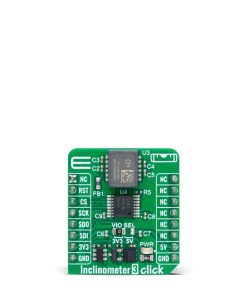Inclinometer 3 Click
R2,450.00 ex. VAT
Inclinometer 3 Click is a compact add-on board for precise tilt and leveling measurement applications. This board features the SCL3400-D01, a two-axis inclinometer sensor from Murata, leveraging advanced capacitive 3D-MEMS technology. It features a high-performance mixed-signal ASIC with a flexible SPI digital interface housed in a robust 12-pin pre-molded casing, ensuring long-term reliability and performance. The sensor offers selectable measurement modes, high resolution up to 32768LSB/g, and ultra-low noise density, making it highly accurate and versatile. It is ideal for precise tilt sensing and leveling applications, such as structural health monitoring, inertial measurement units, and positioning and guidance systems.
Inclinometer 3 Click is fully compatible with the mikroBUS™ socket and can be used on any host system supporting the mikroBUS™ standard. It comes with the mikroSDK open-source libraries, offering unparalleled flexibility for evaluation and customization. What sets this Click board™ apart is the groundbreaking ClickID feature, enabling your host system to seamlessly and automatically detect and identify this add-on board.
Stock: Lead-time applicable.
| 5+ | R2,327.50 |
| 10+ | R2,205.00 |
| 15+ | R2,082.50 |
| 20+ | R2,004.10 |


























